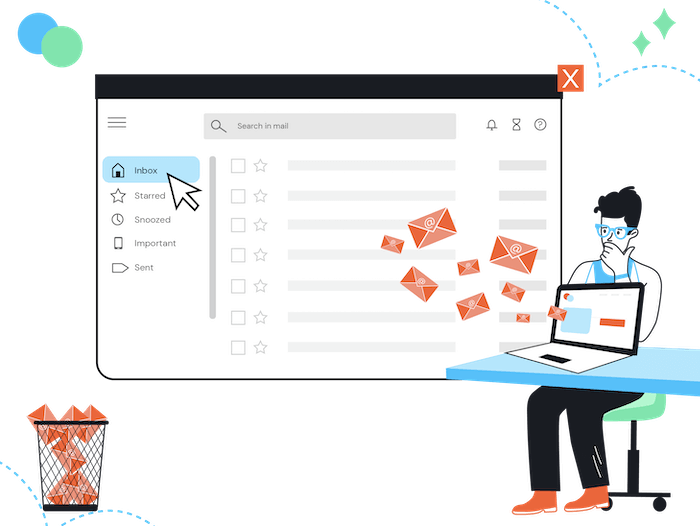In an ideal world, all your contacts would engage with every email you send. After all, they consented to receive marketing emails from you, right?
Unfortunately, anyone who's ever dabbled in email marketing knows that this is rarely (if ever), the case.
In reality, many contacts don’t open emails from businesses, let alone read and click through. Worse, some unsubscribe and even report the emails as spam!
So, how do you create emails that attract, engage and convert contacts?
Short answer: targeted email marketing.
Sending targeted emails to your contacts is one of the secrets to building an effective email marketing strategy, because they persuade contacts to open, read and click links in your emails.
In this article, you'll learn (with practical examples), how to create successful targeted email marketing campaigns, that are sure to increase your engagement rates and drive conversion.
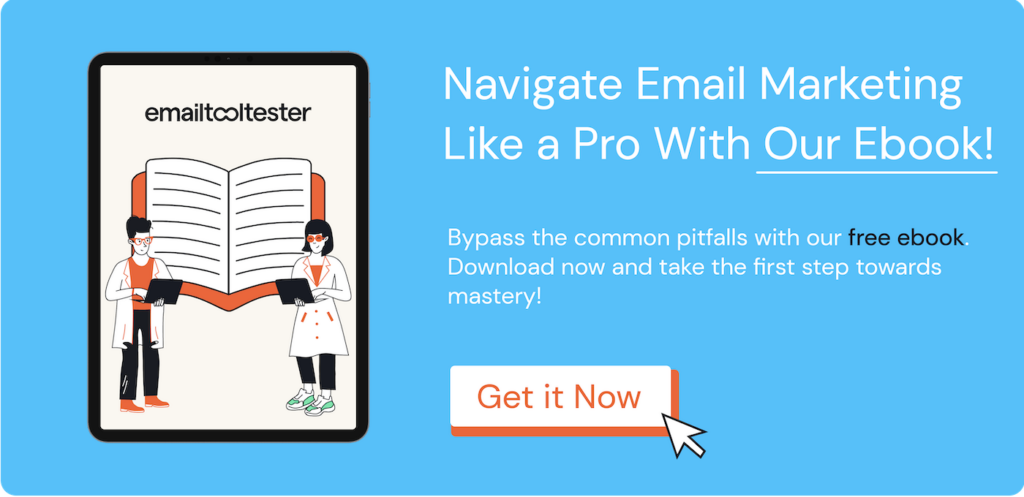
What is Targeted Email Marketing?
Targeted email marketing is a digital marketing strategy that involves sending emails to a specific audience or group of people who are more likely to be interested in the product or service being promoted.
The goal is to personalize the email content to make it more relevant and engaging to the recipient, which can result in higher open and click-through rates, and ultimately, higher conversion rates.
It involves first segmenting your contacts into groups, based on shared demographic and behavioral characteristics, and then sending them emails tailored to their particular interests and needs. (Many of these can be automated – see here for some automated email examples.)
A very basic targeting example is a realtor, who creates a targeted email marketing campaign by segmenting their list into home sellers and home buyers. And then, sends the former emails offering them property valuations, and sends the latter emails showcasing available homes for sale.
Why is Targeted Email Marketing Important?
Targeted email marketing is important because nobody likes generic emails that are full of irrelevant information! Think about it. Do you open emails that don’t interest you? I usually swipe left to delete.
Targeted email marketing helps you only send relevant emails that interest your contacts and that will persuade them to take your desired action.
Imagine sending emails about a “Free Shipping to Europe” offer to your contacts in the U.S. It’s irrelevant to these contacts, so they won’t engage.
With targeted email marketing, you’ll only send the email to contacts segmented by location to be residing in Europe. And, you can even further personalize the emails based on their purchase or browsing history (more on this later).
To sum it up, targeted email marketing is important because:
1. Your emails will be more relevant to your contacts
Targeted email marketing uses segmentation to create emails that are directly relevant to your contact's characteristics and behaviors, which will make them more interesting to each contact.
2. Your contacts are more likely to respond
People respond to emails that are relevant to them. This doesn’t mean that your contact will necessarily reply to your emails. But that they’ll respond by taking your desired actions, such as opening your email and clicking on links.
3. It will help you build a relationship with your contacts
Sending targeted emails will help you build a strong bond with your contacts. They’ll look forward to receiving your emails because of the value you offer. And, even share your emails and offers with family, friends, and colleagues.
4. It will improve your contact retention
Sending emails that really resonate with your contacts' interests, and that they look forward to receiving, will help you retain existing customers and turn one-off buyers into returning customers.
5. It will increase your revenue
When your contacts receive relevant targeted emails, respond to them, and have a relationship with your business, they’re more likely to convert. And, a higher conversion rate equals more revenue!
Plus, sending engaging emails that your contacts interact with is one of the best practices for email deliverability.
Personalized vs Targeted Emails
Personalized emails are customized for individual contacts using their personal information. On the other hand, targeted emails are focused on specific segments of your email list.
While the goal of personalized emails is to connect on a personal level with each contact, the purpose of targeted emails is to engage with a wider group: a specific segment of your list.
However, despite being different, they both help improve your email marketing campaigns. They will engage and resonate with your contacts, which leads to increased open and conversion rates and prevents unsubscribes and spam reports.
Although one can be done without the other, you should consider combining personalized and targeted emails to get better email marketing results.
How to Create a Successful Targeted Email Marketing Campaign
Let’s take a look at 6 steps to create a successful targeted email marketing campaign.
1. Define and collect the data you need
There’s no targeting without relevant data. You need information about your contacts and their behaviors to send them targeted emails.
So, the first step to creating a successful targeted email marketing campaign is to define and collect the data you need.
How do you define the data you need?
By identifying data that is relevant to your business offers.
Not all contact data will be relevant to your business. Just because some businesses collect a specific type of data from their contacts, doesn’t mean it makes sense for you to do the same.
For instance, if you’re a B2C business, you don’t need your contacts’ company names to send them targeted emails. While, if you’re a B2B company, you may want to customize your emails with the contact’s company name.
Understanding your target audience also helps with defining the data you need. This will enable you to identify your audience’s different segments and personalization levels, thereby identifying the data to collect.
Overall, the data you define could be demographic, such as names, age and location. Or behavioral, such as browsing behaviors, cart abandons, and email clicks. After defining the data to collect, you can then decide on how to collect it.
Here are some strategies for collecting contacts’ and customers’ data:
a. Using subscription forms
This can be a sign-up form to subscribe to your email list, or a lead magnet form to collect emails for email marketing. It could also be a registration form, if your business website requires registration to access your services.
With these forms, you can collect basic demographic data such as your contact’s name, age, location, job title, and company name. You can then segment the list based on this information.
We've even added a drop-down to collect the user's industry, which we can then use when segmenting our list.
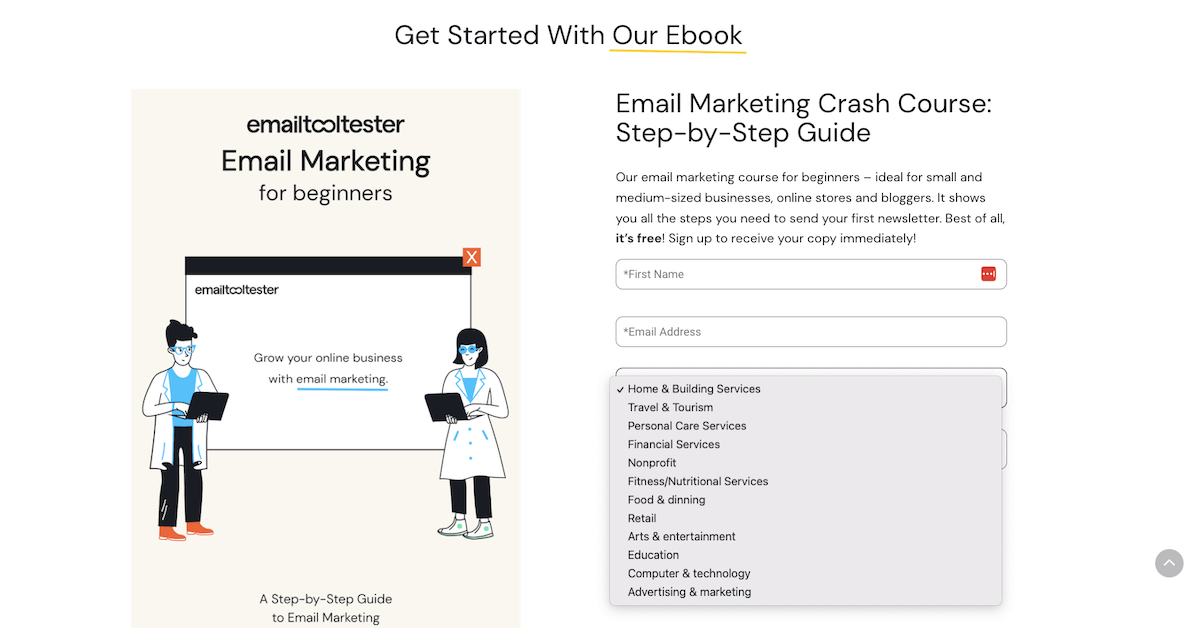
b. Conducting surveys
Surveys enable you to collect more data directly from your contacts. You can use online form builders to create survey forms asking contacts about their interests and needs.
For more info on this, check out the best online form builders for creating surveys without coding.
Also, customer feedback surveys can help you learn more about their preferences. Make sure you offer an incentive to get contacts and customers to participate in your survey.
For instance, if you run a food-related business, you can survey your contacts’ food preferences. Let’s say there are vegans on your list; you can segment and send them targeted email campaigns promoting vegan recipes and products.
c. Integrating your ESP with your CRM & online store
Integrating your email service provider (ESP) with your CRM and online store allows you to indirectly access contacts and customers’ data. This can include data such as browsing behavior and purchase preferences.
For instance, if you have an online store, you can easily collect customers’ locations from their delivery address. You can also learn about their activities on your website by accessing the data on your CRM.
2. Define customer personas
Customer personas are fictionalized representations of your ideal customers, based on your contact’s characteristics, behaviors, goals, motivation, and pain points. They can be built with the data you collected in step 1.
When you’re running targeted email campaigns, the various segments of your list can be based on different customer personas. This allows you to create targeted emails that will resonate with the contacts in each segment.
For instance, if you’re a dentist, the customer persona of contacts needing braces will be different from those needing a root canal removed. While the former wants to feel less conscious about their teeth, the latter is motivated by pain. Hence, you’ll target them with different emails.
Information to define your customer personas can be collected from customer surveys and feedback. However, I also like to use the voice of customer data from forums and social media platforms where your ideal customers hang out.
3. Create your segments
An integral part of email list management, segmentation is a vital part of creating targeted email campaigns, and involves using the customer personas to group your contacts based on their characteristics (demographic) and interactions with your business (behavioral).
Say you run a U.S. travel agency that offers tours and vacation packages to different destinations around the world. You can send targeted emails to different segments based on their location, time, demographics, position in the sales funnel, behavior and preference.
a. Location
Segmenting by location allows you to send location-based offers to your contacts. For instance, you may segment the travel agency list into contacts who reside in the West Coast and the East Coast.
Then, send targeted email campaigns promoting tour and vacation packages in destinations close to the contacts. For example, you may promote Hawaii vacations to contacts in the West Coast, and Europe tours to those in the East Coast.
b. Time
Segmenting your list based on time enables you to send targeted emails at a time when contacts are likely to take action. For the travel agency, you can create segments based on the season your contacts like to vacation. (This strategy also works if you're running email marketing campaigns for hotels.)
Then, you can send targeted emails based on the time of the year. During winter, you can promote ski-resort vacations to those interested in winter vacations. And, promote tours to tropical destinations during Summer to those interested in summer vacations.
c. Demographics
Demographic data like age, gender, and occupation can also be used to create segments for targeted email campaigns. For instance, you can segment the travel agency contacts based on their age range.
For contacts aged 25-34, you could send targeted emails promoting beach vacations, city breaks and romantic getaways. While for those aged 60+, you could send emails promoting senior-friendly tours, river cruises and all-inclusive vacations.
d. Position in the sales funnel
A contact who just joined your email list and one who has already purchased your products or services are in different positions in the sales funnel. Targeted emails help move contacts to the next step in your email funnel.
For the first group, you could send emails highlighting the benefits of booking their vacation with your agency and offering incentives to book. For the second group, you could offer exclusive loyalty discounts on their next vacation booking.
e. Behavior
Behavioral segmentation helps you group contacts based on their interaction with your business. For instance, you can segment contacts who showed interest in a vacation with the travel agency, but didn’t book.
Then, you can send them targeted email campaigns reminding them of their interest and offering discounts on the vacation package they were interested in (sort of like an abandonment cart email).
f. Preferences
This segmentation strategy allows you to offer contacts more of what they prefer (based on their answers to surveys or email preference settings). For instance, the travel agency could segment contacts into budget and luxury travelers.
Then, budget travelers would be sent targeted emails offering budget-friendly vacation packages. While luxury travelers would receive emails promoting comforts in high-end resorts.
Here’s an example of an email that utilizes behavioral segmentation to target contacts who are interested in traveling to San Diego.
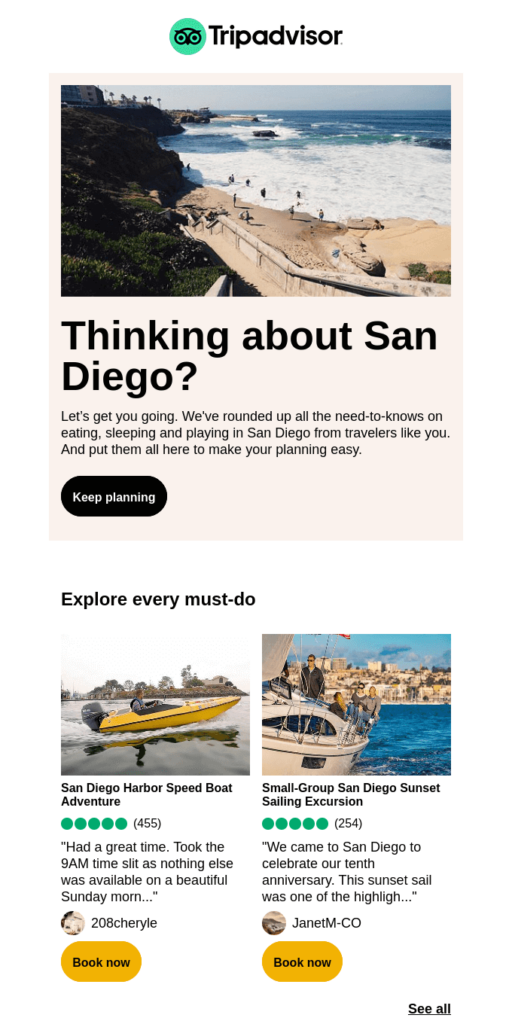
Image Credit: Really Good Emails
4. Create personalized emails
While targeted email marketing allows you to send emails to subgroups of your contacts that share some of the same characteristics, behaviors and interests, we can go further than this.
Email personalization enables you to create targeted emails tailored to each specific contact on your segmented list. This helps you send highly relevant emails that build even stronger relationships with your contacts and customers.
So, from your subject lines to the email copy and CTA, your email can be personalized to resonate with each contact. The most simple example of how you would do this is by adding their name.
Personalizing your subject line with your contact’s name can improve your open rate by 50%. And, a personalized email copy and CTA will engage them better and increase the likelihood of conversion.
To personalize your emails effectively, you will, of course, need your contacts’ personal information and behavioral data.
Also, the degree of personalization will depend on your target audience. For instance, your tone of voice for B2C contacts will be more casual than for B2B contacts.
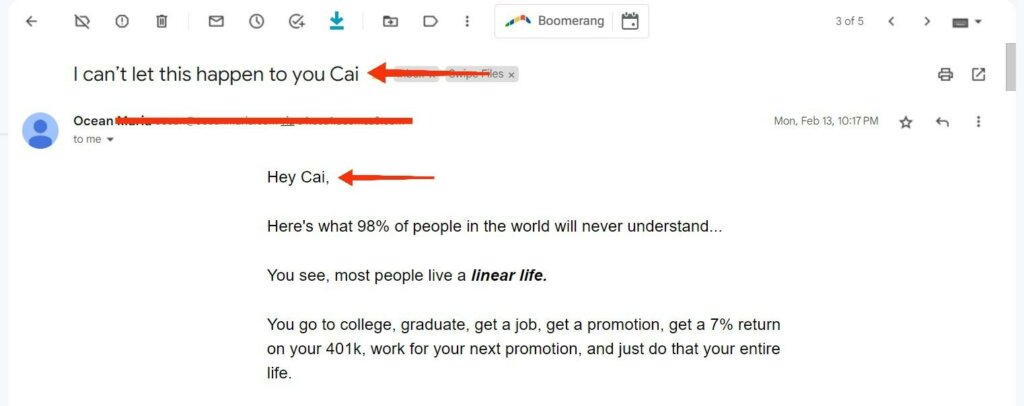
For more information, check out our email personalization guide, as well as our tips on how to write better marketing emails.
5. A/B Test
Test and analyze everything. No targeted email marketing strategy is guaranteed to be successful. And what works today might not work tomorrow.
You have to A/B test to figure out what works best for your business and contacts, and continually refine your strategies
With email A/B testing, you can test two emails or strategies to determine which works best. Your subject lines, email copy and images, and CTA are some parts of your email you can test.
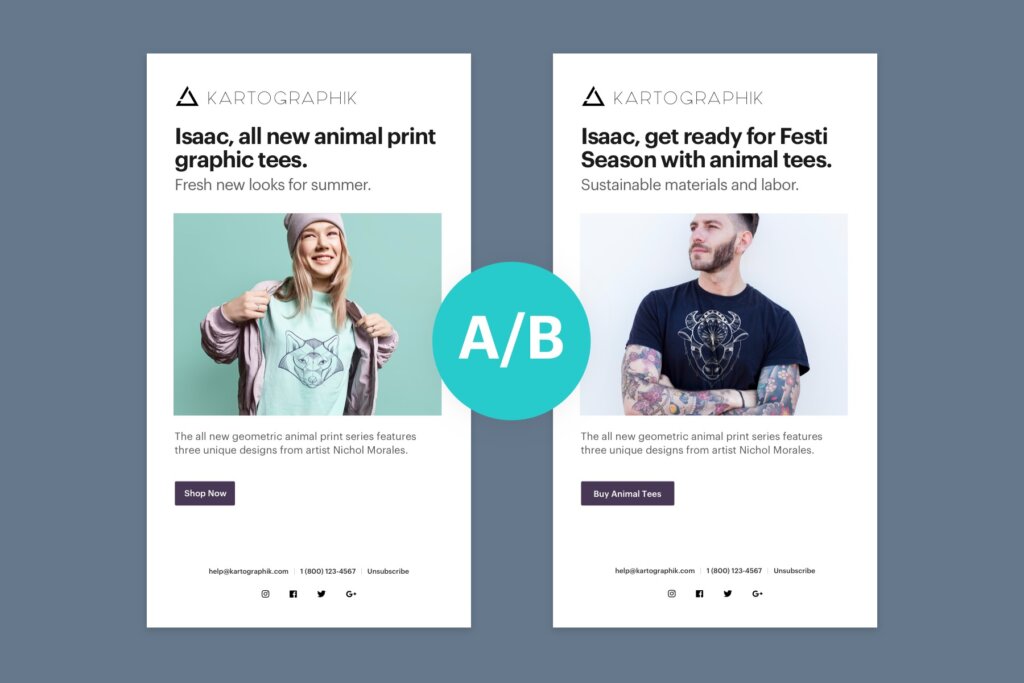
Image Credit: Weebly
After A/B testing, use result metrics like open rate, click-through rate and even unsubscribes to determine the email or strategy that works best.
An example of testing your strategy is A/B testing when you send emails to determine the best time to send emails to your contacts. You can send emails in the morning, evening, or on separate days to determine what time works best.
6. Use the right email marketing tool
Creating a successful targeted email marketing campaign manually is impossible. You need the right email marketing tool to automate the entire process.
There are numerous ESPs offering email marketing services. However, when choosing a provider, ensure that the tool (or the plan you choose) provides all the features you need to send targeted emails.
Some features to look for include sign-up forms, advanced segmentation and tags, dynamic text, A/B testing, and CRM and ecommerce integration.
If you’re on a limited budget, I recommend GetResponse. Otherwise, ActiveCampaign is a great choice as it’s an advanced email marketing tool with all these features and more. For more in depth analysis, check out our guides to the best ESPs and CRMs.
Targeted Email Marketing: Conclusion
If you want to improve your email marketing campaigns and start seeing great results, you should create targeted email marketing campaigns.
And to do this, you need to collect relevant data, segment your contacts and personalize your emails to suit your customer persona. Also, ensure that you use the right email marketing tool, and don’t forget to test and tweak your emails to get better results.
Follow the steps to deliver targeted emails to the right contact at the right time, and you’ll drive more engagement and increase conversions for your business. When you do, share how well it worked for your business in the comments.
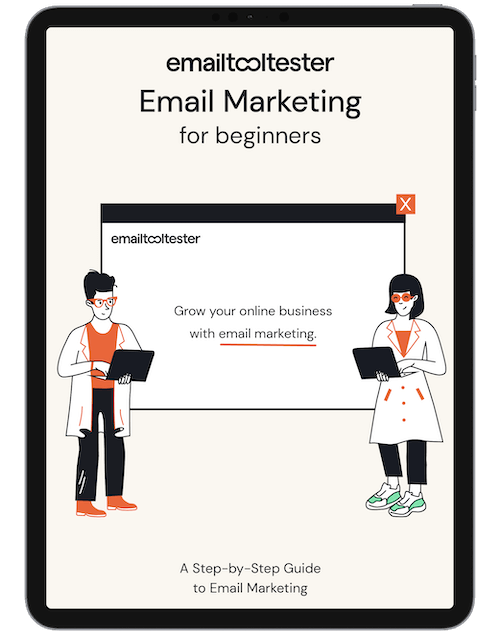
Email Marketing Ebook: Beginner's Guide
Sign up to receive your free copy and avoid common mistakes!
Our Methodology
This article has been written and researched following our EmailTooltester methodology.
Our Methodology